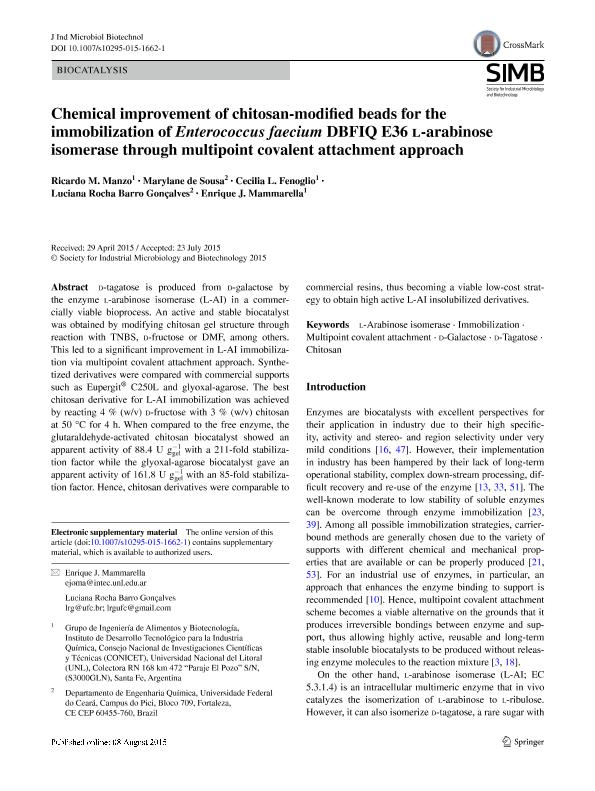Artículo
Chemical improvement of chitosan-modified beads for the immobilization of Enterococcus faecium DBFIQ E36 l-arabinose isomerase through multipoint covalent attachment approach
Manzo, Ricardo Martín ; de Sousa, Marylane; Fenoglio, Cecilia Lorena
; de Sousa, Marylane; Fenoglio, Cecilia Lorena ; Gonçalves, Luciana Rocha Barro; Mammarella, Enrique José
; Gonçalves, Luciana Rocha Barro; Mammarella, Enrique José
 ; de Sousa, Marylane; Fenoglio, Cecilia Lorena
; de Sousa, Marylane; Fenoglio, Cecilia Lorena ; Gonçalves, Luciana Rocha Barro; Mammarella, Enrique José
; Gonçalves, Luciana Rocha Barro; Mammarella, Enrique José
Fecha de publicación:
10/2015
Editorial:
Springer Heidelberg
Revista:
Journal of Industrial Microbiology & Biotechnology
ISSN:
1367-5435
Idioma:
Inglés
Tipo de recurso:
Artículo publicado
Clasificación temática:
Resumen
d-tagatose is produced from d-galactose by the enzyme l-arabinose isomerase (L-AI) in a commercially viable bioprocess. An active and stable biocatalyst was obtained by modifying chitosan gel structure through reaction with TNBS, d-fructose or DMF, among others. This led to a significant improvement in L-AI immobilization via multipoint covalent attachment approach. Synthetized derivatives were compared with commercial supports such as Eupergit® C250L and glyoxal-agarose. The best chitosan derivative for L-AI immobilization was achieved by reacting 4 % (w/v) d-fructose with 3 % (w/v) chitosan at 50 °C for 4 h. When compared to the free enzyme, the glutaraldehyde-activated chitosan biocatalyst showed an apparent activity of 88.4 U ggel −1 with a 211-fold stabilization factor while the glyoxal-agarose biocatalyst gave an apparent activity of 161.8 U ggel −1 with an 85-fold stabilization factor. Hence, chitosan derivatives were comparable to commercial resins, thus becoming a viable low-cost strategy to obtain high active L-AI insolubilized derivatives.d-tagatose is produced from d-galactose by the enzyme l-arabinose isomerase (L-AI) in a commercially viable bioprocess. An active and stable biocatalyst was obtained by modifying chitosan gel structure through reaction with TNBS, d-fructose or DMF, among others. This led to a significant improvement in L-AI immobilization via multipoint covalent attachment approach. Synthetized derivatives were compared with commercial supports such as Eupergit® C250L and glyoxal-agarose. The best chitosan derivative for L-AI immobilization was achieved by reacting 4 % (w/v) d-fructose with 3 % (w/v) chitosan at 50 °C for 4 h. When compared to the free enzyme, the glutaraldehyde-activated chitosan biocatalyst showed an apparent activity of 88.4 U ggel −1 with a 211-fold stabilization factor while the glyoxal-agarose biocatalyst gave an apparent activity of 161.8 U ggel −1 with an 85-fold stabilization factor. Hence, chitosan derivatives were comparable to commercial resins, thus becoming a viable low-cost strategy to obtain high active L-AI insolubilized derivatives.
Archivos asociados
Licencia
Identificadores
Colecciones
Articulos(INTEC)
Articulos de INST.DE DES.TECNOL.PARA LA IND.QUIMICA (I)
Articulos de INST.DE DES.TECNOL.PARA LA IND.QUIMICA (I)
Citación
Manzo, Ricardo Martín; de Sousa, Marylane; Fenoglio, Cecilia Lorena; Gonçalves, Luciana Rocha Barro; Mammarella, Enrique José; Chemical improvement of chitosan-modified beads for the immobilization of Enterococcus faecium DBFIQ E36 l-arabinose isomerase through multipoint covalent attachment approach; Springer Heidelberg; Journal of Industrial Microbiology & Biotechnology; 42; 10; 10-2015; 1325-1340
Compartir
Altmétricas



